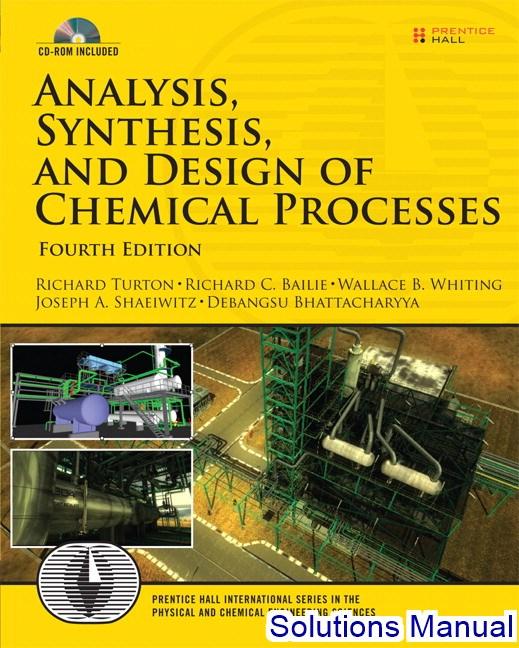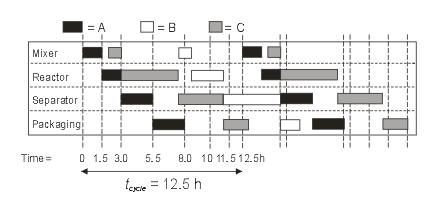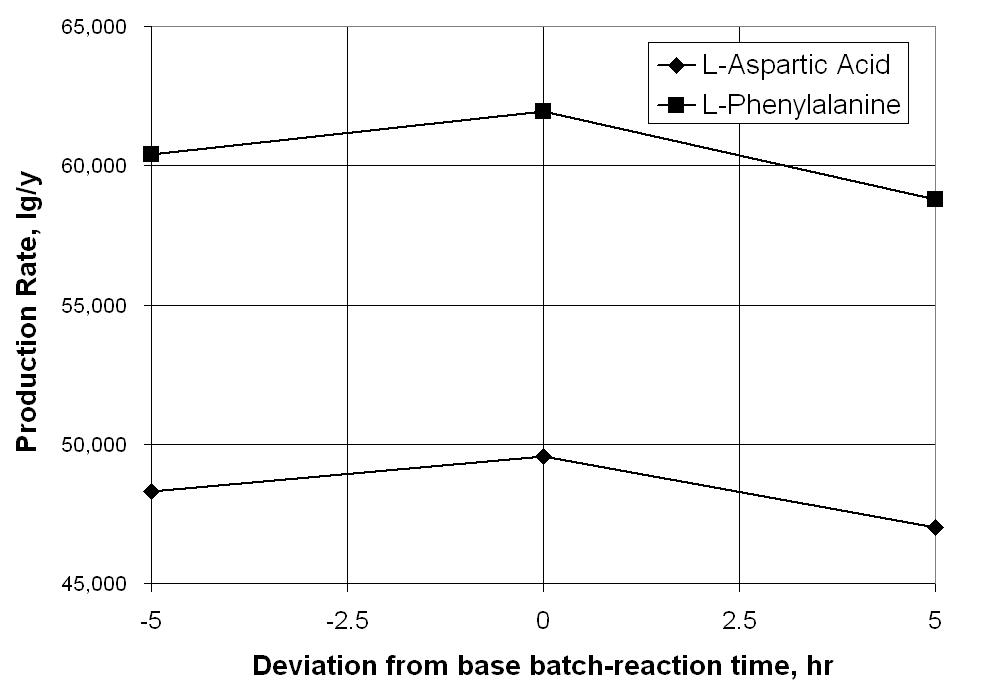
Chapter 3
3.1. What is a flowshop plant?
A flowshop plant is a plant in which several batch products are produced using all or a subset of the same equipment and in which the operations for each batch follow the same sequence. Thus the flow of any batch through equipment A, B, C, D … is always
A→B→C→D→…. Omissions of equipment are possible but no reversal in direction is allowed.
3.2. What is a jobshop plant?
A flowshop plant is a plant in which several batch products are produced using all or a subset of the same equipment but for which the operations of at least one batch product do not follow the same sequence, e.g., A→C→D→B
3.3. What are the two main methods for sequencing multiproduct processes?
Either use multi-product campaigns or multiple single-product campaigns.
3.4. Give one advantage and one disadvantage of using single-product campaigns in a multiproduct plant.
Advantage – sequencing of single-product campaigns is relatively simple and repetitive and probably less prone to operator error since the batch recipe remains the same over the entire campaign.
Disadvantage – significant final product storage will be required since all products will not be made all the time and in order to even out supply some inventory of products will have to be maintained in storage. Single-product campaigns may be less efficient than multiproduct campaigns.
3.5. What is the difference between a zero-wait and a uis process?
A zero-wait process is one in which the batch is transferred immediately from the current piece of equipment to the next piece of equipment in the recipe sequence. This type of process eliminates the need for intermediate storage (storage of unfinished products or intermediates).
A uis (unlimited intermediate storage) process is one in which any amount of any intermediate product may be stored. Such a process maximizes the use of the processing equipment but obviously requires an unlimited amount of storage.
3.6 Number of batches of A is twice that for B or C – repeat Example 3.3 with this restriction using a 500 h cycle time.

Table E3.3: Equipment times needed to produce A, B, and C
Using Equation (3.6) with tcycle,A = 2.5,
= 4.5
If x is the number of batches of Products B and C, then 2x is the number of batches of Product A
Number of batches for each product are A = 70, B=35, C=35
3.7 For Examples 3.3 and 3.4, determine the number of batches that can be produced in a month (500 h) using a multi-product campaign strategy with the sequence ACBACBACB. Are there any other sequences for this problem other than the one used in Example 3.4 and the one used here?
The multi-product cycle time = 2.5 + 2.0 + 3.5 + 4.5 = 12.5 h
Number of batches per month = (500)/(12.5) = 40 each of A, B, and C
The only sequences that can be used for multi-product campaigns are ABCABCABC (Example 3.4) and ACBACBACB as used here.
3.8 Consider the multi-product batch plant described in Table P3.8
Table P3.8: Equipment Processing Times for Processes A, B, and C
It is required to produce the same number of batches of each product. Determine the number of batches that can be produced in a 500 h operating period using the following strategies:
(a) using single-product campaigns for each product
Using Equation (3.6) with tcycle,A = 5.0, tcycle,B = 4.0, and tcycle,C = 4.5
x = 37 batches
(b) using a multi-product campaign using the sequence ABCABCABC…
From this diagram we see that the cycle time for the multi-product campaign using the sequence ABC is 12.5 h.

Therefore, the number of batches, x, of each product that can be made during a 500 h period is given by:
x = 40 batches
(c) using a multi-product campaign using the sequence CBACBACBA…

From this diagram we see that the cycle time for the multi-product campaign using the sequence ABC is 13.5 h. Therefore, the number of batches, x, of product that can be made during a 500 h period is given by:
x = 37 batches
3.9 Consider the process given in Problem 3.8. Assuming that a single-product campaign strategy is repeated every 500 h operating period and further assuming that the production rate (for a year = 6,000 h) for products A, B, C are 18,000 kg/y, 24,000 kg/y, and 30,000 kg/y, respectively, determine the minimum volume of product storage required. Assume that the product densities of A, B, and C are 1100, 1200, and 1000 kg/m3, respectively
The tables below shows the results using data given from Problem 8
Let the single-product campaign times for the three products be tA, tB, and tC, respectively.
Applying Equation (3.6), the following relationship is obtained:
The number of campaigns per product is then given by tx/tcycle,x and
Furthermore, the volume of a batch is found by multiplying Equation (3.10) by vreac,x, and equating batch volumes for the different products yields:
Solving Equations (3.9) and (3.12), yields:
Clearly the number of batches should be an integer value. Rounding these numbers yields
For product A
Number of batches = 10
tA = (10)(6.0) = 60 h
VA = (12,500)(0.0073)/(10) = 9.13 m3
For product B
Number of batches = 17
tB = (17)(9.5) = 161.5 h
VB = (17,500)(0.0095)/(17) = 9.78 m3
For product C
Number of batches = 15
tC = (15)(18.5) = 277.5 h
VC = (30,000)(0.0047)/(15) = 9.40 m3
Total time for production cycle = 499 h ~ 500 h
Volume of reactor = 9.78 m3 (limiting condition for Product B)
Table P3.11: Batch step times (in hours) for Reactor and Bacteria Filter for Project 8 in Appendix B
*includes 5 h for filling, cleaning, and heating plus 5 hours for emptying
(a) let
tA = campaign time for L-aspartic acid
tP = campaign time for L-phenylalanine
Assuming equal recovery ratios for each amino acid we have
Solving we get
tA = 1944 h
tP = 6056 h
yearly production of L-aspartic acid = (1944)(1020)/(40) = 49,560 kg
yearly production of L-phenylalanine = (6056)(716)/(70) = 61,950 kg
Number of batches per year for L-aspartic acid = (1944)/(40) = 48
Number of batches per year for L-phenylalanine = (6056)/(70) = 86
(b) For each product calculate the average yearly demand and production rate in m3/h and then find the storage needed for each product
(c) Rework part (b) using a 1 month cycle time = 8,000/12 = 666.67 h
Assuming equal recovery ratios for each amino acid we have
Solving we get tA = 162 h and tP = 504.7 h monthly production of L-aspartic acid = (4)(1020) = 4,080 kg monthly production of L-phenylalanine = (7)(716) = 5,012 kg
Number of batches per month for L-aspartic acid = (162)/(40) = 4
Number of batches per month for L-phenylalanine = (504.7)/(70) = 7
Note that these are rounded down so that integer numbers are given per month this gives rise to a slightly lower production rate per year than before.
These values are (not surprisingly) approximately 1/12 of the previous results
3.12
(a) Referring to Project B.8, Figures B.8.2 and B.8.3 and using batch reaction times for Laspartic acid and L-phenylalanine of 25 and 55 h, respectively. We get the following information:
Conversion of L-aspartic acid = 42% (84% of equilibrium) (base case = 45%)
Exit concentration of L-phenylalanine = 18.5 kg/m3 (base case = 21%)
tA = campaign time for L-aspartic acid
tP = campaign time for L-phenylalanine
Assuming equal recovery ratios for each amino acid we have
Solving we get
tA = 1776 h
tP = 6224 h
yearly production of L-aspartic acid = (1776)(952)/(35) = 48,316 kg
yearly production of L-phenylalanine = (6224)(630.8)/(65) = 60,395 kg
Number of batches per year for L-aspartic acid = (1776)/(35) = 50 or 51
Number of batches per year for L-phenylalanine = (6224)/(65) = 95 or 96
Therefore, the number of batches increases but the yearly production decreases
(b) Referring to Project B.8, Figures B.8.2 and B.8.3 and using batch reaction times for Laspartic acid and L-phenylalanine of 35 and 65 h, respectively. We get the following information:
Conversion of L-aspartic acid = 47% (94% of equilibrium) (base case = 45%)
Exit concentration of L-phenylalanine = 21.5 kg/m3 (base case = 21%)
tA = campaign time for L-aspartic acid
tP = campaign time for L-phenylalanine
Assuming equal recovery ratios for each amino acid we have
tA = 1986 h
tP = 6014 h
yearly production of L-aspartic acid = (1986)(1065)/(45) = 47,002 kg
yearly production of L-phenylalanine = (6014)(733)/(75) = 58,777 kg
Number of batches per year for L-aspartic acid = (1986)/(45) = 44
Number of batches per year for L-phenylalanine = (6014)/(75) = 80
Therefore, the number of batches decreases and the yearly production decreases – plot the results from problems 11 and 12
This shows that the base case conditions are close to optimal.

3.13
a. Let x be the number of batches of A in a 600-h period.
tcycle,A = 5.0 h
tcycle,B = 5.5 h
tcycle,C = 5.0 h
5.0x+ 5.5(2x) + 5.0(3x) = 600 h
⇒ x = 600/(5 + 11 + 15) = 600/31 = 19.4 batches
x = 19 – rounded down (but one could round up)
A = 19 batches
B = 38 batches
C = 57 batches
b. Demand in one month of C is 180,000/12 = 15,000 kg/month
#batches = 57, tcycle,C = 5.0 h ⇒ (5)(57) = 285 h/month operating time
production rate = 15,000/285 = 52.63 kg/h (52.63 kg/h)/(850 kg/m3) = 0.06192 m3/h
demand rate = 15,000/850/600 = 0.02941 m3/h
Vstorage = (0.06192-0.02941 m3/h)(285 h) = 9.27 m3
c. Crystallizer is limiting piece of equipment
⇒ t
=
# repeats = 600/30.5 = 19.7
# batches same as part a
3.14 a. nB = nC =2nA = n
tcycle,A = 3.5 h
tcycle,B = 4.0 h
tcycle,C = 3.0 h
⇒ 0.5n(3.5) + 4n + 3n = 600 h
n(1.75 + 4 + 3) = 600
n = 68.6 batches – round to 69
nB = nC = 69 batches
nA = 34 batches
b. ABBCCABBCC – as shown on figure - crystallizer is limiting

tcycle = ABBCC = 3.5 + (4.0 + 4.0) + (3.0 + 3.0) = 17.5
n(17.5) = 600
n = 34.3
nB = nC = 69 batches
nA = 34 batches same as above
c. 2n(3.5) + 4n + 3n = 600
n = 600/14 = 42.9
nB = nC = 43 batches
nA = 85 or 86 batches
d.
rd = 17.5/600 = 0.02917 m3/h
rp = 17.5/[(4)(69)] = 0.06341 m3/h
tcampaign = 4(69) = 276 h
VS,B = (rp–rd)tcampaign = (0.06341-0.02917)(276)
VS,B = 9.45 m3
